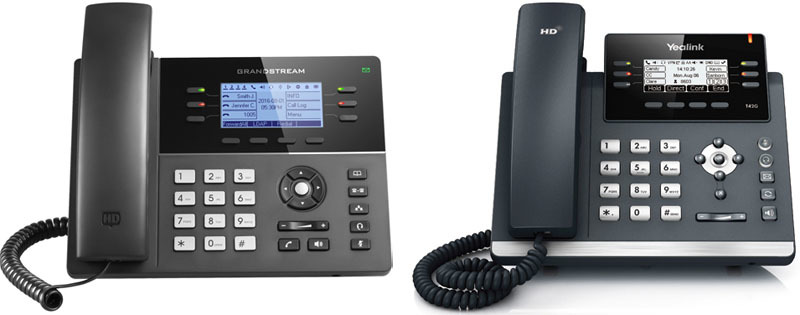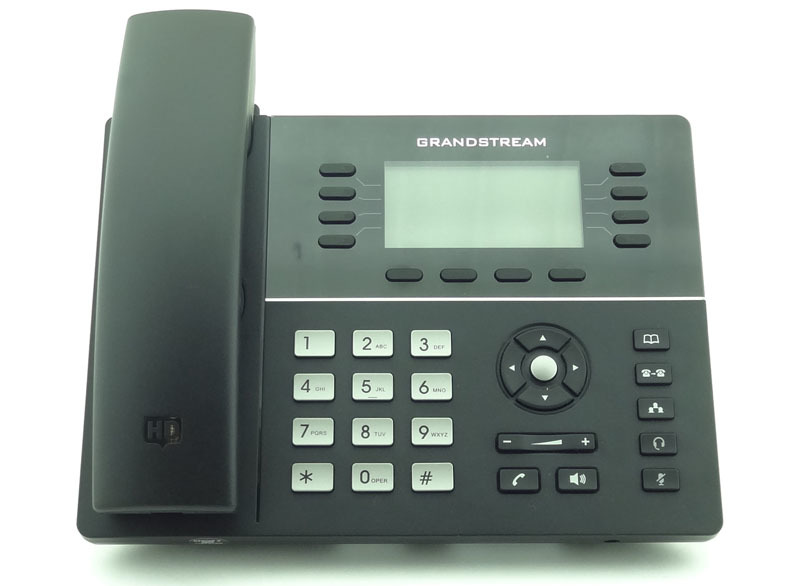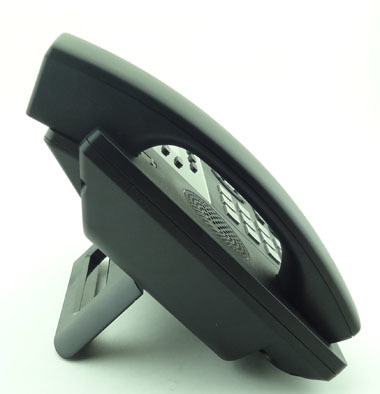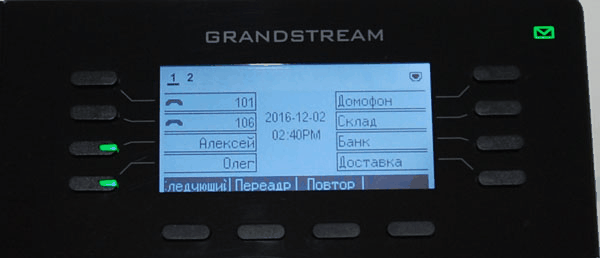New series of IP phones Grandstream GXP1700
In late November 2016, Grandstream Networks announced the launch of a new line of IP phones. The new model range GXP1700 belongs to the average price range and includes three models - GXP1760, GXP1780 and GXP1782. Tellingly, the new devices are not replacing the outdated models, but expanding the already rather big product line of Grandstream IP phones. Why does the manufacturer need it and what are the novelties - we will try to understand this article.

At the moment, Grandstream company produces two model series of IP-phones. These are conditionally budget line GXP1600 and conditionally premium GXP2100. Conventionally, because, for example, the oldest phone of the sixteenth series GXP1630 with three lines, 8 BLF keys, with not the smallest display and the price ($ 85) falls into the budget category is already very conditional. The situation is similar with the GXP2130 - the cheapest device ($ 105) from the older series. The only thing that can refer it to the category of premium phones is a color display.
But, despite all the conventions, a certain gap in positioning between these two series of phones still exists, and new models are designed to fill this void. This is what Grandstream marketers are pushing for, calling the GXP1700 series nothing less than “Mid-Range IP Phones”. I see another reason for the emergence of a new model range, but this is exclusively my subjective opinion. On the left in the photo is the youngest model of the Grandstream GXP1760 phones, and on the right is the Yealink SIP-T42G IP phone from the Yealink SIP-T4 model line that is quite popular in the United States and Europe. It is clear that there is no direct borrowing here, but the phones are stylistically quite similar. In this way, trying to win back part of the market from a competitor is, in my opinion, a rather logical and understandable idea.

')
As already mentioned, the new model range consists of three devices and they are all quite similar. GXP1780 and GXP1782 are generally twin brothers, the only difference is that the two-way model supports Gigabit Ethernet, but the GXP1780 does not. There are slightly more differences from the older models of the GXP1760 : first, a smaller number of SIP accounts (3 vs. 4) and lines (6 vs. 8) are supported. Secondly, the number of BLF keys on the left and right of the display was reduced from eight to six, due to which the number of actions programmed on them was reduced from 32 to 24. Grandstream sent us to test the oldest model GXP1782, which we will learn today. However, everything written will also be applicable to the other two phones of the series, taking into account the amendments mentioned above.

The appearance of the GXP1782 is fully consistent with modern trends in the design of IP-phones. These are black matte plastic at the bottom and a black glossy frame at the top. The keys are fairly large, rectangular in shape with minimal rounding. The numeric keys are made under metallic with black silk-screen printing, the rest - in the classic black color with white inscriptions. The phone tube is wide and not very curved, because of this, it is not very convenient to remove it from the phone. The phone itself is also quite wide, so that all the elements are located on it quite freely and do not put pressure on each other.

Of the original features of the appearance, you can highlight the bright light strip that separates the top of the phone from the bottom and a rather nice voice mail indicator next to the display, which is almost invisible when it is turned off. It is a pity that Russian users, who are largely unaccustomed to using voice mail, will not notice this original move by Grandstream designers.


The display of the new Grandstream phones is graphic black and white with backlighting. The resolution is 200 by 80 points, the diagonal is 3.4 inches, the brightness of the backlight and the level of contrast are adjustable. Grandstream GXP1782 is another proof that the black-and-white display in the case of IP phones often outperforms those with color convenience. All information is displayed clearly, read easily, without stress. A beautiful picture on the phone screen is not the second or even the tenth thing.

The only thing that upsets and surprises a little is the organization of the graphical interface of the phone. In particular, only two of the four programmable keys located below the display are enabled by default. They perform the function of "call back" and on / off call forwarding. In the web interface, you can assign an action to two other keys, but there are no options available, for example, such an important function as “do not disturb”. To turn this mode on and off, you have to go deep into the menu, which is very inconvenient.
From the standard context-sensitive keys, let's move on to the main feature of the new phones - the BLF LED keys, which are located to the left and right of the display. More precisely, BLF is just one of several available features, so Grandstream prefers to call these keys virtual multifunction keys (Virtual Multi-Purpose Keys, VPK). In addition to the BLF function, the keys can perform such functions as active line selection, speed dialing, dialing in tone mode, intercom calling, call recording, call parking, intercom, paging, and others.
Despite the fact that physically there are only 8 keys (for the GXP1760 - six), each of them can perform up to 4 different actions. Switching between actions is done by flipping through the virtual pages of the screen (so the keys are called virtual). Of course, such a solution is less convenient than the presence of 32 hardware keys, but in this case the phone would have turned out much more cumbersome and expensive.

Let's move from the front of the phone to the back. On it we see two network ports: one megabit in the case of the GXP1760 / GXP1780 and one gigabit in the case of the GXP1782. Naturally, there are two 4P4C connectors for connecting a handset and a conventional wired headset. When Plantronics headsets are used, the Electronic Tube Lifting (EHS) feature is supported when calls can be accepted, rejected and terminated directly from the headset. There is also a separate EHS port reserved for future use of an external EHS adapter.

All new phones support the ability to power over PoE (maximum consumption - 5 W). Despite this, Grandstream, according to the old tradition, packs all its phones with power supplies, and does not offer to purchase them separately. The microUSB port is used as the power connector, as is the case with all recent Grandstream products. This is convenient: firstly, such an adapter is always easy to find, and secondly, there is always something to charge your smartphone (if this is, of course, not an IPhone).
In addition to the microUSB port, there are phones and a full-fledged USB, hidden behind a plastic cap. Its application is very limited: at the moment it can only be used to store Pcap data. However, there is still one useful application for this port - this is again charging the smartphone and other devices. The last of the connectors on the back of the phone is a Kensington lock.

Like all modern Grandstream phones, new devices do not stand out in terms of sound quality, both in normal mode and in speakerphone mode. The sound is quite normal, no rejection, as, however, does not cause delight. Of course, “HD” is written on the handsets, which means that they support the G722 wideband codec. However, I would have paid even more attention to supporting the free Opiofioformate Opus, which is still quite rare in other IP phones.
New Grandstream phones support all major phone features. From the interesting and unusual here it is possible to single out perhaps the possibility of organizing 5-sided conferences without using PBX resources and a truly huge telephone book for 2000 numbers. Filling it in manually is almost impossible, but there is a possibility to import via XML. Search in the LDAP directory is also supported.
As for network functions, first of all, it is worth noting support for OpenVPN (work with TLS-certificates is not supported yet). Also, security is ensured by supporting SIPS and SRTP protocols. To control the access of phones to the network, 802.1X support is provided. When installing a large number of devices in the local network, VLAN and QoS will not be redundant.
The configuration options for new Grandstream phones are standard - this is the on-screen menu (can be disabled for security purposes), the Web interface, as well as automatic configuration from TFTP, HTTP and HTTPS servers. With regard to the management and monitoring of the phones, support for TR-069 and LLDP protocols can help.
Unfortunately, at the time of this writing, the Grandstream GXP1700 series phones are not yet on sale in Russia, so their exact price is not yet known. However, the indicative figures are as follows: the GXP1760 will sell for $ 105 at retail, the GXP1780 for $ 112 and the GXP1782 for $ 117. This is a very good price for functional, comfortable and, in my opinion, quite stylish phones. Another question is how relevant are the mid-range phones for the current economic realities of our country, when customers every year are guided by more and more low-end IP-phone models? We will begin to receive the answer to this question already at the end of this - the beginning of next year, when the phones of the new series will be on sale in Russia.

At the moment, Grandstream company produces two model series of IP-phones. These are conditionally budget line GXP1600 and conditionally premium GXP2100. Conventionally, because, for example, the oldest phone of the sixteenth series GXP1630 with three lines, 8 BLF keys, with not the smallest display and the price ($ 85) falls into the budget category is already very conditional. The situation is similar with the GXP2130 - the cheapest device ($ 105) from the older series. The only thing that can refer it to the category of premium phones is a color display.
But, despite all the conventions, a certain gap in positioning between these two series of phones still exists, and new models are designed to fill this void. This is what Grandstream marketers are pushing for, calling the GXP1700 series nothing less than “Mid-Range IP Phones”. I see another reason for the emergence of a new model range, but this is exclusively my subjective opinion. On the left in the photo is the youngest model of the Grandstream GXP1760 phones, and on the right is the Yealink SIP-T42G IP phone from the Yealink SIP-T4 model line that is quite popular in the United States and Europe. It is clear that there is no direct borrowing here, but the phones are stylistically quite similar. In this way, trying to win back part of the market from a competitor is, in my opinion, a rather logical and understandable idea.

')
As already mentioned, the new model range consists of three devices and they are all quite similar. GXP1780 and GXP1782 are generally twin brothers, the only difference is that the two-way model supports Gigabit Ethernet, but the GXP1780 does not. There are slightly more differences from the older models of the GXP1760 : first, a smaller number of SIP accounts (3 vs. 4) and lines (6 vs. 8) are supported. Secondly, the number of BLF keys on the left and right of the display was reduced from eight to six, due to which the number of actions programmed on them was reduced from 32 to 24. Grandstream sent us to test the oldest model GXP1782, which we will learn today. However, everything written will also be applicable to the other two phones of the series, taking into account the amendments mentioned above.
Appearance and ergonomics

The appearance of the GXP1782 is fully consistent with modern trends in the design of IP-phones. These are black matte plastic at the bottom and a black glossy frame at the top. The keys are fairly large, rectangular in shape with minimal rounding. The numeric keys are made under metallic with black silk-screen printing, the rest - in the classic black color with white inscriptions. The phone tube is wide and not very curved, because of this, it is not very convenient to remove it from the phone. The phone itself is also quite wide, so that all the elements are located on it quite freely and do not put pressure on each other.

Of the original features of the appearance, you can highlight the bright light strip that separates the top of the phone from the bottom and a rather nice voice mail indicator next to the display, which is almost invisible when it is turned off. It is a pity that Russian users, who are largely unaccustomed to using voice mail, will not notice this original move by Grandstream designers.


Display and interface
The display of the new Grandstream phones is graphic black and white with backlighting. The resolution is 200 by 80 points, the diagonal is 3.4 inches, the brightness of the backlight and the level of contrast are adjustable. Grandstream GXP1782 is another proof that the black-and-white display in the case of IP phones often outperforms those with color convenience. All information is displayed clearly, read easily, without stress. A beautiful picture on the phone screen is not the second or even the tenth thing.

The only thing that upsets and surprises a little is the organization of the graphical interface of the phone. In particular, only two of the four programmable keys located below the display are enabled by default. They perform the function of "call back" and on / off call forwarding. In the web interface, you can assign an action to two other keys, but there are no options available, for example, such an important function as “do not disturb”. To turn this mode on and off, you have to go deep into the menu, which is very inconvenient.
BLF keys
From the standard context-sensitive keys, let's move on to the main feature of the new phones - the BLF LED keys, which are located to the left and right of the display. More precisely, BLF is just one of several available features, so Grandstream prefers to call these keys virtual multifunction keys (Virtual Multi-Purpose Keys, VPK). In addition to the BLF function, the keys can perform such functions as active line selection, speed dialing, dialing in tone mode, intercom calling, call recording, call parking, intercom, paging, and others.
Despite the fact that physically there are only 8 keys (for the GXP1760 - six), each of them can perform up to 4 different actions. Switching between actions is done by flipping through the virtual pages of the screen (so the keys are called virtual). Of course, such a solution is less convenient than the presence of 32 hardware keys, but in this case the phone would have turned out much more cumbersome and expensive.

Ports and connectors
Let's move from the front of the phone to the back. On it we see two network ports: one megabit in the case of the GXP1760 / GXP1780 and one gigabit in the case of the GXP1782. Naturally, there are two 4P4C connectors for connecting a handset and a conventional wired headset. When Plantronics headsets are used, the Electronic Tube Lifting (EHS) feature is supported when calls can be accepted, rejected and terminated directly from the headset. There is also a separate EHS port reserved for future use of an external EHS adapter.

All new phones support the ability to power over PoE (maximum consumption - 5 W). Despite this, Grandstream, according to the old tradition, packs all its phones with power supplies, and does not offer to purchase them separately. The microUSB port is used as the power connector, as is the case with all recent Grandstream products. This is convenient: firstly, such an adapter is always easy to find, and secondly, there is always something to charge your smartphone (if this is, of course, not an IPhone).
In addition to the microUSB port, there are phones and a full-fledged USB, hidden behind a plastic cap. Its application is very limited: at the moment it can only be used to store Pcap data. However, there is still one useful application for this port - this is again charging the smartphone and other devices. The last of the connectors on the back of the phone is a Kensington lock.

Sound quality
Like all modern Grandstream phones, new devices do not stand out in terms of sound quality, both in normal mode and in speakerphone mode. The sound is quite normal, no rejection, as, however, does not cause delight. Of course, “HD” is written on the handsets, which means that they support the G722 wideband codec. However, I would have paid even more attention to supporting the free Opiofioformate Opus, which is still quite rare in other IP phones.
Telephone and network functions
New Grandstream phones support all major phone features. From the interesting and unusual here it is possible to single out perhaps the possibility of organizing 5-sided conferences without using PBX resources and a truly huge telephone book for 2000 numbers. Filling it in manually is almost impossible, but there is a possibility to import via XML. Search in the LDAP directory is also supported.
As for network functions, first of all, it is worth noting support for OpenVPN (work with TLS-certificates is not supported yet). Also, security is ensured by supporting SIPS and SRTP protocols. To control the access of phones to the network, 802.1X support is provided. When installing a large number of devices in the local network, VLAN and QoS will not be redundant.
The configuration options for new Grandstream phones are standard - this is the on-screen menu (can be disabled for security purposes), the Web interface, as well as automatic configuration from TFTP, HTTP and HTTPS servers. With regard to the management and monitoring of the phones, support for TR-069 and LLDP protocols can help.
Price
Unfortunately, at the time of this writing, the Grandstream GXP1700 series phones are not yet on sale in Russia, so their exact price is not yet known. However, the indicative figures are as follows: the GXP1760 will sell for $ 105 at retail, the GXP1780 for $ 112 and the GXP1782 for $ 117. This is a very good price for functional, comfortable and, in my opinion, quite stylish phones. Another question is how relevant are the mid-range phones for the current economic realities of our country, when customers every year are guided by more and more low-end IP-phone models? We will begin to receive the answer to this question already at the end of this - the beginning of next year, when the phones of the new series will be on sale in Russia.
Source: https://habr.com/ru/post/399637/
All Articles